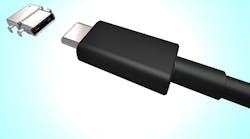This file type includes high-resolution graphics and schematics when applicable.
Technology Editor talked with Abdullah Raouf, Senior Product Marketing Manager for Lattice Semiconductor, about the different technologies supported by, and key features within, the USB Type-C standard.
Wong: What will USB Type-C (USB-C) be able to do that previous USB generations could not?
Raouf: USB Type-C offers six key features that make this a flexible and extensible connector:
Reversible plug orientation and cable direction: The USB Type-C connector is symmetrical in that it can be inserted in either orientation. This addresses a major complaint of past connectors. Additionally, in the past, the connector defined the function of the attached device (Type-A for Hosts and Type-B for Devices). The USB Type-C connector can be attached to either port with the functionality defined by the port hardware itself.
Power: The USB Type-C connector is backward-compatible with the previous A & B connectors, in that it can provide 5 V at up to 1.5 A at the hardware level via an adapter cable. The USB Type-C connector is not physically backward-compatible with any previous USB connectors. However, this connector has four pins, each of which being dedicated to power and ground. Combined with the “USB Power Delivery Specification,” voltages as high as 20 V and currents up to 5 A can be delivered to the USB Type-C port.
Alternate Modes: A minimum of five differential signal pairs on the USB Type-C connector can be repurposed for almost any application. This reassignment of signals is accomplished through a negotiation on the CC lines. The five differential signal pairs can be used for SuperSpeed USB signals, or video signals such as MHL, DisplayPort, etc., a combination of these, or most anything else. In this negotiation, both port partners need to agree to the reassignment prior to any changes.
Bandwidth: USB Type-C can support USB 2.0, USB 3.1 Gen 1 (SuperSpeed USB), and USB 3.1 Gen 2 (SuperSpeed USB 10 Gbps) data speeds. USB 2.0 and USB 3.1 are defined under separate specifications. SuperSpeed USB differential-pair signals are assigned to the outer part of the connector, so each insertion orientation will use one set of SuperSpeed USB signaling connections.
Channel Configuration: Two Channel Configuration signals (CC1 & CC2) in the USB Type-C connector allow negotiation through the link. These signals determine connector attachment and orientation. These are also used to negotiate the power provided on the connector as well as Alternate Modes and Accessory Modes.
Accessory Modes: Physical space on portable devices is severely constrained. As mentioned, the USB Type-C specification has addressed this by providing an extensible connector to support a variety of applications. Accessory Modes further extend this flexibility. The first of these modes to be defined is the Audio Accessory Mode. This mode allows for a set of standard headphones to be plugged into the USB Type-C connector.
Wong: What are Alternate Modes (Alt Modes)?
Raouf: Alternate Mode (Alt Mode) refers to a mode over the USB Type-C link that allows for signaling other than USB data to be transferred. To enter/exit an Alt Mode, both sides of the USB Type-C connection must support Power Delivery (PD) negotiation to establish a Power Contract. Power Contracts are defined within the USB Power Delivery specification and utilize the CC lines from the USB Type-C link.
Bidirectional communication messages are passed between the USB Type-C ports where capabilities and requirements are established. When a capability and requirement is matched between two ports, a Power Contract can be established. A successful Power Contract occurs when both sides of the USB Type-C cable agree upon the power level (voltage and current) to be transferred. An Alt Mode can be negotiated only after establishing a Power Contract. For more information on establishing a Power Contract, please check out the USB Power Delivery specification.
Certain pins on the 24-pin connector can be used to transfer different signals. Eight USB 3.1 SuperSpeed pins can be reassigned for non-USB 3.1 signaling. Two other pins, SBU1 and SBU2, can be reassigned for non-USB signaling. In a detachable cable scenario, these 10 pins are the only pins that can be used for Alt Mode signals. In addition, devices utilizing a captive cable can reassign the VCONN signal on pin B5 along with unused pins B6 and B7. The process of entering and exiting an Alt Mode utilizes Vendor Defined Messages (VDMs).
Wong: What are Vendor Defined Messages?
Raouf: VDMs are unique by nature due to an ID field in each message. There are two categories of IDs: Standardized ID (SID) and Vendor (specific) ID (VID). SID and VIDs are assigned by USB-IF and have the same structure. USB-IF assigns SIDs to standards groups that have a liaison agreement with USB-IF and assigns VIDs to USB-IF member and non-member companies.
Companies can then use their VID to establish a proprietary link that would only work between their own Upstream Facing Port (UFP), analogous to a legacy USB device, and Downstream Facing Port (DFP), analogous to a legacy USB host. Third-party systems will not be able to establish the same proprietary link. Examples of SIDs include MHL and DisplayPort over USB Type-C.
In order to enter or exit an Alt Mode, structured VDMs are used. These have well-defined but extensible commands and are modal in behavior. For example, two commands are “Enter Mode” and Exit Mode.” Once an Alt Mode is enabled, there may be a need for specialized commands and data that do not conveniently fit within the defined, structured VDM format. These are called Unstructured VDMs, which enable more flexible vendor-customized formats.
Wong: What kind of user experiences will be enabled by Alt Mode?
Raouf: So far two standardized Alt Modes have been developed by standards groups that have a liaison agreement with the USB Implementers Forum: MHL and DisplayPort. Thunderbolt 3 is a proprietary Alt Mode developed by Intel. MHL and DisplayPort are focused on connecting the USB Type-C-enabled product to an external display. The difference between each Alt Mode is the signaling standard used and the number of pins that are required to support the signaling. Setting up the link for the requested Alt Mode will require a USB-PD port controller that can handle the USB power-delivery negotiation. Both sides of the cable will require a port controller.
Wong: How can OEMs best educate consumers about what version of USB Type-C is supported by a product?
Raouf: Consumers need to understand what functionality is supported. The only mandatory requirement over a USB Type-C connector is the reversibility, USB 2.0 signaling, and 5-V transfer at 500 mA from the DFP to the UFP. Beyond this functionality, logos should be used by OEMs to educate consumers what functionality is supported. USB-IF logos may be used for products that have been certified by the USB-IF and the company has a valid Trademark License Agreement on file with the USB-IF.
The SuperSpeed USB logo will let a consumer know that USB signaling is supported up to 5 Gb/s and the SuperSpeed USB 10Gbps logo will let a consumer know that USB signaling is supported up to 10 Gb/s. Other USB-IF logos indicate whether USB Power Delivery is also supported. In addition, MHL, DisplayPort, or Thunderbolt logos may be used by an OEM in conjunction with the USB-IF logos. These will let a consumer know that one of the three Alt Modes is supported in addition to support for USB functionality.
Wong: When will USB Type-C products that support Alt Mode be available?
Raouf: Products have already been released with Alt Mode support, such as the Apple MacBook and the Google Chromebook Pixel. We’re looking forward to seeing other product releases down the road.


